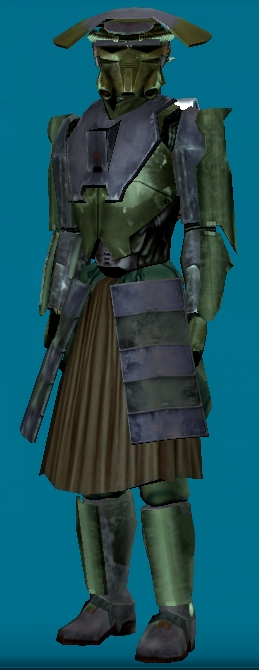
Modular Reinforced Insulated Sheath Armor, also known as RIS armor or the MRIS system, is an advanced type of lightweight, flexible modular unpowered body armor. The Block 2 variant, which provides a full set of armor instead of just a chestplate, is geared towards special operations (SPECCOM) personnel. It typically consists of three layers: a heavy Class 1M-rated primary layer, a Class 1K-rated secondary layer, and a Class 1D-rated tertiary jumpsuit. Block 2 modifications allow for the use of fully interchangeable plates that provide equal amounts of protection across the entire body.
Protection
The MRIS system provides protection by means of interchangeable, removable layers. These typically consist of modular interference-resistant magnetically-connected armor plates, which are hooked up manually to the jumpsuit by means of heavy-duty load-carrying loops. Despite it's low weight and focus on mobility, it provides a high degree of personal protection, especially when the layers are in tandem with one another.
Primary Layer
The primary layer is typically the thickest, and is Class 1M-rated at the minimum. These plates are usually rigid, hard SAPI or Shooter's cut armor plates with a spall liner, with the most common variety consisting of a heavy tritanium alloy plate that covers the front and back of the wearer. While tough, the primary armor layer only usually covers the most essential vital organs, the lungs and heart, due to the restrictive weight of larger 1M-rated plates, although in tandem with the two other layers, there is little to nothing that can penetrate a wearer's vital regions.
A chest-mounted light can be attached to the middle of the primary plate, configured for low-light red, IR, strobe, or white light for various mission needs. The MRIS chest rig's straps can be configured to go over the primary layer without difficulty, provided that the wearer adjusts for the thickness of the plate compared to the secondary layer.
Secondary Layer
The secondary layer protects most of the chest region, although it's rated lower on the protection scale at Class 1K instead of 1M. It is more flexible than the primary layer, consisting of smaller spaced plates with cuts for maximum mobility and ease of access, and is designed to provide the highest degree of lightweight protection against small arms fire that can be afforded to non-vital areas. Attachment points for Flexible Universal Mounts are located on the secondary layer of armor.
Tertiary Layer
Forming the backbone of the MRIS system is the tertiary layer, which consists of a fully-sealed, pressurized, fire-retardant, Class 1D-reinforced armored jumpsuit made of synthetic cloth and tritanium mesh weave to spoof sensors. Typically, it is in uniform black, with provisions on the chest to mount heavier armored plates. A belt keeps the jumpsuit well-fit, and can accommodate personal shield generators or ammunition pouches.
Other
As the plates are worn externally, operators issued MRIS sets typically procure low-profile fabric chest rigs, occasionally with additional soft armor backings for extra protection. These allow operators to easily store and carry auxiliary equipment, backup weapons, and spare reloads. Third-party belts can also be used to store equipment, shield generators, and oxygen tanks, as the MRIS armor is capable of fully pressurizing for use in EVA environments.